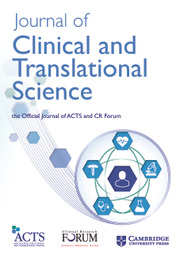No CrossRef data available.
Article contents
471 Defining proteomic and cellular elements of the pancreatic ductal adenocarcinoma (PDAC) tumor microenvironment with mass spectrometry imaging
Published online by Cambridge University Press: 11 April 2025
Abstract
Objectives/Goals: Currently, a lack of screening markers and targeted therapies prevent clinicians from successfully treating PDAC. Precision medicine may allow oncologists to better combat this disease. To personalize care, knowledge of tumor protein posttranslational modifications, extracellular matrix makeup, and infiltrating immune cells is imperative. Methods/Study Population: Matrix-assisted laser desorption ionization mass spectrometry imaging (MALDI-MSI) was employed to characterize the N glycosylation state, the ECM composition, and immune cell populations present within 10 formalin fixed paraffin embedded PDAC patient samples. Molecular dry spray of PNGase F and Collagenase III followed by enzymatic digestion allowed for the release of N glycans and ECM peptides from the tissue. Multiplex immunohistochemistry with photocleavable, mass-tagged probes was also performed on each tissue. This analysis produced a spatial map of N glycans, ECM peptides and immune cells with their distribution and abundance color-coded as a heat map of each tissue. Results/Anticipated Results: This analysis produced a unique N-glycan signature associated with specific tumor regions (necrosis, invasive margin, etc.) and immune cell clusters. Additionally, immune cells within the PDAC tumor microenvironment were found to be organized into immature tertiary lymphoid structures composed primarily of CD20+ B cells. Finally, a distinct distribution of ECM peptides within and surrounding tumor tissue was visualized, and putative identifications have been assigned to these stromal elements. Discussion/Significance of Impact: In the future, insights from this hypothesis-generating study may be leveraged to identify diagnostic and prognostic biomarkers for PDAC to improve early diagnosis and treatment response rates. The N glycan signature, ECM composition, and immune activation state in liquid biopsies including serum and PBMCs will be compared to data from this study.
Information
- Type
- Precision Medicine/Health
- Information
- Creative Commons
- This is an Open Access article, distributed under the terms of the Creative Commons Attribution-NonCommercial-NoDerivatives licence (https://creativecommons.org/licenses/by-nc-nd/4.0/), which permits non-commercial re-use, distribution, and reproduction in any medium, provided the original work is unaltered and is properly cited. The written permission of Cambridge University Press must be obtained for commercial re-use or in order to create a derivative work.
- Copyright
- © The Author(s), 2025. The Association for Clinical and Translational Science

